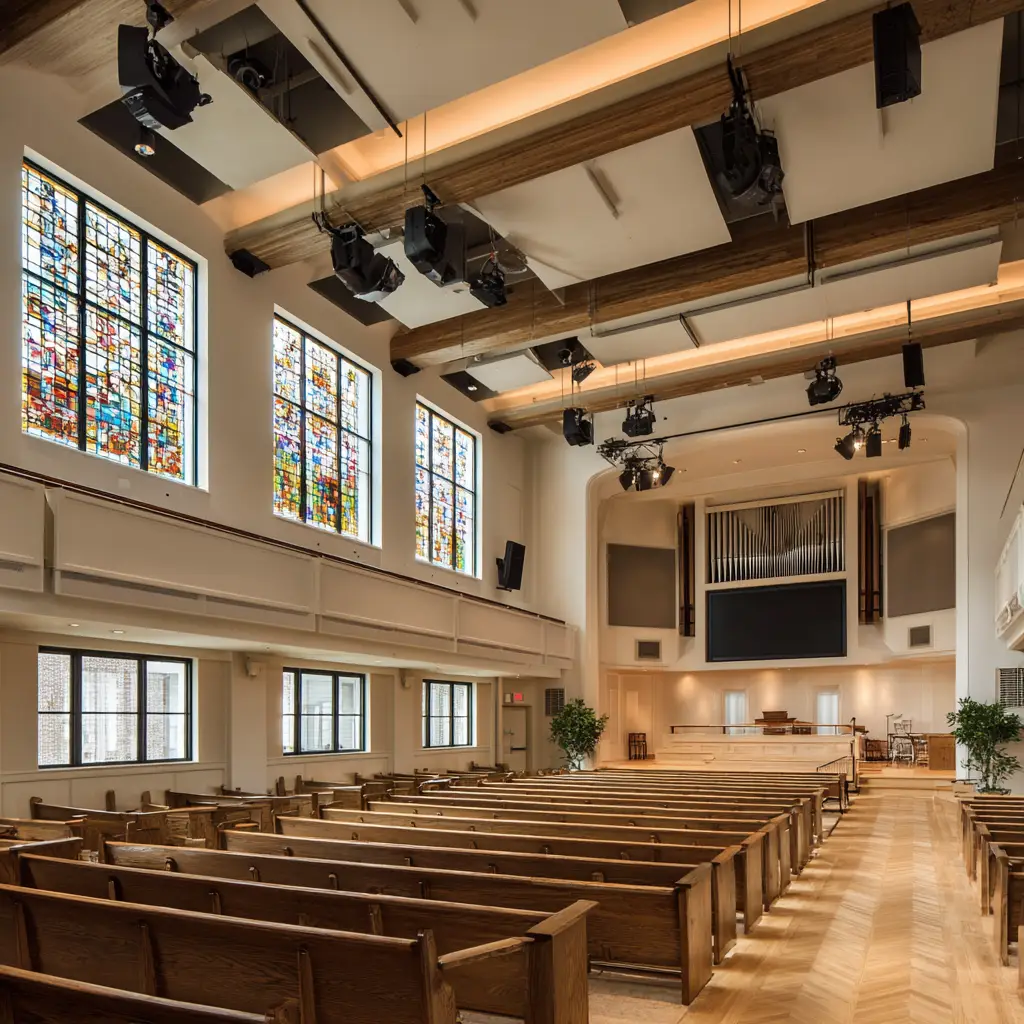
For many churches, sound quality determines how well a message connects with the congregation. When words get lost in echo or music feels uneven, people tune out; not by choice but by fatigue. Upgrading a church sound system can feel intimidating, especially when budgets are limited and every decision must reflect good stewardship. The good news is that clarity doesn’t require a massive investment or brand-new gear. It starts with understanding what truly affects what people hear.
A clear plan helps your team spend wisely, make confident decisions, and get results that actually last. This guide simplifies how to evaluate your space, prioritize improvements, and plan for long-term reliability. By the end, you’ll know exactly where to focus your budget and when to call professionals who understand worship environments.

The room sets the rules: make acoustics your foundation
Every sound system begins with the room itself. You can install the best microphones and amplifiers available, but if the room creates harsh reflections or long reverb tails, even simple speech becomes muddy. Room acoustics set the boundaries for every other upgrade.
Most sanctuaries are built with reflective surfaces, like wood floors, plaster walls, and tall ceilings that encourage resonance. These features look beautiful, but they can scatter sound unevenly. Congregations often experience sharp highs, hollow mids, or dead spots depending on where they sit. That inconsistency is rarely the fault of the gear. It’s the environment shaping what people hear.
Think of acoustic treatment as insulation for your ears. Just like insulation keeps your building energy-efficient, panels and bass traps keep sound energy balanced. Adding absorption on the back wall, diffusers near the ceiling, and modest bass control in corners can instantly improve clarity without touching the mixing console.
Simple changes like moving speakers away from hard corners, hanging curtains, or adding carpet runners under pews can also reduce unwanted echo. Fixing the room first often makes existing equipment sound dramatically better. Before replacing speakers, address the space they play into. Once the acoustics are stable, every other part of the sound system performs at its full potential.
Fit the system to your reality, not someone else’s
Every church is unique. A system that works for a 500-seat auditorium won’t automatically suit a smaller fellowship hall. Instead of copying another setup, start by mapping your specific needs.
Ask what happens in your space each week. Do you primarily deliver spoken sermons, or does your worship include full bands and multiple vocalists? Is there translation or overflow seating? Will the system also handle weddings, youth nights, and livestreams? These details determine what kind of coverage pattern, amplifier power, and microphone selection you actually need.
Coverage always matters more than volume. Aim for even sound, not just a louder sound. One person at the back should hear as clearly as someone sitting up front. Proper speaker type and placement (more directional speakers positioned correctly) often outperform bigger systems with poor alignment.
Consider the people running the soundboard too. Volunteers without professional training need intuitive workflows. Choosing a user-friendly mixer with labeled scenes can save hours of frustration each week. Finally, plan for growth without overspending today. Modular systems or scalable digital mixers can expand later without forcing a complete rebuild.
By designing around your real activities and space, you create a sound system that feels natural and supportive rather than overwhelming or over-engineered.
Spend where it counts: high-impact pieces vs. nice-to-haves
Budget decisions can make or break an installation. The best approach is to focus on upgrades that deliver immediate clarity and reliability. Everything else can wait.
Speakers and placement deserve the largest share of your budget. Well-placed speakers determine whether sound coverage feels balanced or uneven. Invest in quality transducers that match your room size and mount them correctly for even dispersion.
Next, prioritize microphones. The quality of your source defines everything downstream. Cheap handhelds and aging lapels can cause constant feedback or dull tone. Upgrading to reliable, well-matched mics gives a cleaner signal before it ever hits the mixer.
Basic DSP and system tuning also provide huge returns. A professional setup using digital processing can align delays, manage EQ, and smooth transitions between zones. Even subtle tuning changes can make speech intelligible without needing extra power.
Lastly, consider monitoring solutions for musicians or speakers. Personal monitor mixers or simple floor wedges prevent performers from pushing the main system too hard.
What can wait? Expensive control screens, decorative metering, and high-end accessories. They look impressive, but rarely fix clarity issues.
When comparing gear, remember that commercial-grade equipment is designed for continuous operation and predictable performance, unlike consumer electronics meant for occasional home use.
For deeper insight, explore why commercial equipment is engineered differently. It explains how reliability, safety ratings, and serviceability justify professional-grade choices for a worship environment.
If you stream, you’re mixing for two rooms
Churches that livestream their services effectively serve two audiences at once: those in the room and those online. Each environment hears things differently, so treating them as identical rarely works.
The most common mistake is sending the main mix directly to the stream. Room acoustics, crowd noise, and natural reverb make that feed sound distant or unbalanced. A separate mix path ensures online listeners experience clarity comparable to being in the sanctuary.
This doesn’t mean you need a second engineer. For smaller setups, an auxiliary or matrix mix fed from the main console can deliver a cleaner stream signal. Adjusting vocal levels, reducing room reverb, and lightly compressing dynamics creates a more professional broadcast sound.
If streaming is central to your ministry, plan the infrastructure early. Adding cameras, switchers, and network audio after the fact often causes patchwork issues. A thoughtful design that supports both live and online audiences helps maintain consistency week after week.
Streaming isn’t an optional add-on anymore; it’s part of modern outreach. Building your system with that in mind avoids extra costs later and preserves the same clear message across every platform.

DIY with wisdom, call pros when it protects stewardship
Volunteers play an essential role in church AV, and many tasks can be handled internally with a bit of guidance. Labeling cables, keeping racks tidy, managing presets, and performing basic troubleshooting are all achievable through regular training. A consistent checklist keeps everything running smoothly without needing constant outside help.
Still, some areas call for experienced professionals. Rigging speakers safely, grounding electrical systems, and modeling room coverage require precise calculations. Mistakes in these stages can become expensive or even unsafe. In those moments, professional design and commissioning protect both your budget and your people.
A qualified integrator can tune the system for even frequency response, reduce dead zones, and verify all safety standards. Working with experts who understand worship spaces is not an expense; it’s long-term stewardship.
If your church is considering a full redesign or installation, explore RYGID AV’s expertise in church AV installation and worship space audio solutions. Their teams specialize in spaces where spoken word and music must coexist clearly and faithfully. Partnering with experienced professionals ensures every upgrade aligns with your mission and avoids wasted investment.
Plan smart, build in phases, and ask better questions
Building the right sound system is not about chasing trends or buying everything at once. It is about taking logical, well-paced steps. Start with the room itself, tailor your design to how your congregation actually worships, spend where clarity counts, plan for both in-person and streaming needs, and know when expert help ensures lasting results.
By following these principles, your church will end up with a system that sounds balanced, serves every listener, and remains sustainable for years. A well-tuned sound environment does not just amplify voices; it strengthens connection and clarity, further amplifying the worship experience.
If a quick, no-pressure conversation would help confirm priorities and phasing, consider a short consultation with RYGID AV for church AV installation or worship space audio solutions.
Where to Contact + Connect with RYGID AV
Mooresville, NC 28117

.webp)